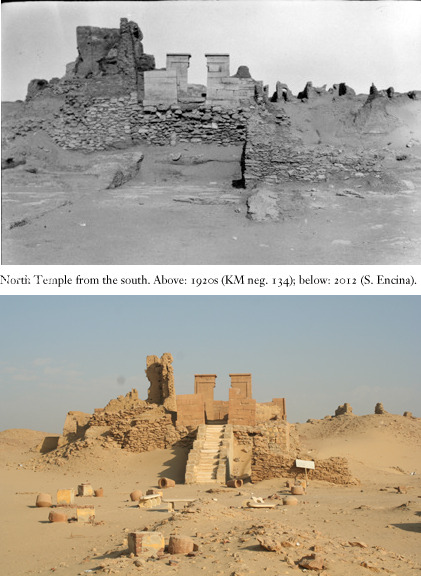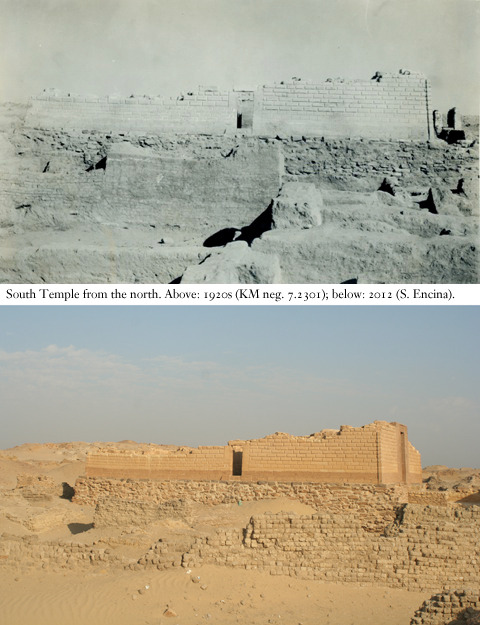
 BY SEBASTIAN ENCINA, Collections Manager, Kelsey Museum of Archaeology, University of Michigan
BY SEBASTIAN ENCINA, Collections Manager, Kelsey Museum of Archaeology, University of Michigan
A month has passed since I arrived at Karanis, and work has been progressing well. Several areas are open at the moment, encompassing different sections of the site. The team is working mostly in areas not excavated by the Michigan team in the 1920s, outside the original Michigan boundaries. So far they have been excavating at a granary to the east of the North Temple, a kiln south of the South Temple, and a bathhouse north of the North Temple.
The finds from all sections have been interesting. Plenty of pottery has been found throughout the site, which is not at all surprising. Most of it consists of body sherds, but on occasion the team has found more unusual pieces, including filtered rims and whole vessels.
Glass and terracotta are still appearing. Fragments of a mask, possibly, and fragments of a shrine, potentially, have been excavated at the granary. This trench has also yielded a leather sandal, two large stone basins, and a mortar.
The site of Karanis has been a blessing for scholars for the amounts and types of materials discovered. This includes organics, which are still present: seeds, charcoal, textiles, and animal remains have come up in great numbers. Most interesting of all, though, are the large baskets and rope/cordage found. The weaving patterns used and shapes are reminiscent of those in the Kelsey collections.
There have been a few surprises thus far. The granary team found a pen that could have held animals, but its construction is puzzling. Walls were added that appear to serve no purpose. There is a hole in the wall, but its placement is right behind the newly built wall. Room 1 in the granary has a low-wall bin that seems quite small to have held much.
Unfortunately, one trench, the kiln, lies in the area destroyed by the sebakhim (farmers who dug up mudbricks for reuse). The levels here are disturbed, though they are still yielding plenty of finds. The room has two kilns, one small and one large. Though one glass fragment was found, it is likely this kiln was used for ceramics, as plenty of pottery and slag are found in the trench.
Due to ongoing work at Karanis, I will not be posting pictures of finds, as the team will likely want to publish their materials. However, I can show personal pictures of the site to give the reader a sense of the state of the town. Much has changed since Michigan left in 1935. Buildings that once stood prominently are covered by sand. Walls that towered over workers no longer exist. Wall paintings, decorated niches, dovecotes, arches are no longer visible. Some have been covered by backfill. Some have been claimed by the desert sands. Some have been destroyed by human hands.
When I return to Ann Arbor, I will present additional photographs to show the difference between 1920s Karanis and 2012 Karanis. Most has changed as detailed above. But the images shown here give a glimpse of how some structures remain unchanged.
A month has passed since I arrived at Karanis, and work has been progressing well. Several areas are open at the moment, encompassing different sections of the site. The team is working mostly in areas not excavated by the Michigan team in the 1920s, outside the original Michigan boundaries. So far they have been excavating at a granary to the east of the North Temple, a kiln south of the South Temple, and a bathhouse north of the North Temple.
The finds from all sections have been interesting. Plenty of pottery has been found throughout the site, which is not at all surprising. Most of it consists of body sherds, but on occasion the team has found more unusual pieces, including filtered rims and whole vessels.
Glass and terracotta are still appearing. Fragments of a mask, possibly, and fragments of a shrine, potentially, have been excavated at the granary. This trench has also yielded a leather sandal, two large stone basins, and a mortar.
The site of Karanis has been a blessing for scholars for the amounts and types of materials discovered. This includes organics, which are still present: seeds, charcoal, textiles, and animal remains have come up in great numbers. Most interesting of all, though, are the large baskets and rope/cordage found. The weaving patterns used and shapes are reminiscent of those in the Kelsey collections.
There have been a few surprises thus far. The granary team found a pen that could have held animals, but its construction is puzzling. Walls were added that appear to serve no purpose. There is a hole in the wall, but its placement is right behind the newly built wall. Room 1 in the granary has a low-wall bin that seems quite small to have held much.
Unfortunately, one trench, the kiln, lies in the area destroyed by the sebakhim (farmers who dug up mudbricks for reuse). The levels here are disturbed, though they are still yielding plenty of finds. The room has two kilns, one small and one large. Though one glass fragment was found, it is likely this kiln was used for ceramics, as plenty of pottery and slag are found in the trench.
Due to ongoing work at Karanis, I will not be posting pictures of finds, as the team will likely want to publish their materials. However, I can show personal pictures of the site to give the reader a sense of the state of the town. Much has changed since Michigan left in 1935. Buildings that once stood prominently are covered by sand. Walls that towered over workers no longer exist. Wall paintings, decorated niches, dovecotes, arches are no longer visible. Some have been covered by backfill. Some have been claimed by the desert sands. Some have been destroyed by human hands.
When I return to Ann Arbor, I will present additional photographs to show the difference between 1920s Karanis and 2012 Karanis. Most has changed as detailed above. But the images shown here give a glimpse of how some structures remain unchanged.


















 BY SEBASTIAN ENCINA, Collections Manager, Kelsey Museum of Archaeology, University of Michigan
BY SEBASTIAN ENCINA, Collections Manager, Kelsey Museum of Archaeology, University of Michigan
